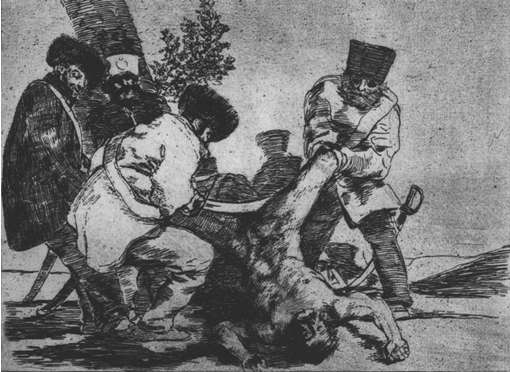What More Can be Done? (Goya)

…. Still haven’t done it — written that entry about how and why Francisco Goya’s life and work relates to the mess we’re in today — but while I was out for an errand this afternoon, I passed a used book shop and saw in the window Gwyn A. Williams’s wonderful book, Goya and the Impossible Revolution. It was a sign: Williams’s 1976 pithy rendering is just simply it, and what were the chances of stumbling on this nearly 30-year-old treasure?
On the first page of the book we see a reproduction of one of Goya’s prints from the Disasters of War, #26. It’s called “One can’t look” (illustrated above). We see a largely black print accented by several brightly lit figures. At the right edge, we see starkly lit bayonets jutting into the darkness on the left. The guns are pointing at a group of huddled victims, in the midst of which, centrally placed, is a woman in white. Her arms are outstretched; she is comforted by another figure (woman?) who huddles her cheek into the woman’s exposed neck. We see a puzzle of clasped hands, bawling children, women covering themselves entirely with cloths, women trying to avoid the light as the enlightening jab of the bayonets penetrates their lair. Men are among them, and together they are a group of unarmed, nameless peasants facing death.
Williams’s book begins in that middle, thus:
The executioners we do not see. Their rifles thrust in from the right, sharp with bayonets, inhuman and implacable. The eye follows their thrust, from a twilit grey into a blackness. Who are these huddled people? They are ordinary, common; their probably unremarkable lives are ending now in brutal, wanton, faceless killing. They die without heroism or dignity which makes it an obscenity. One man kneels in prayer, face turned from the rifles. Another, nearer to us, looks at them in futile entreaty. Between the men, light cuts through to a cowled woman huddling protectively over a child, to a face buried in hands, to a woman stretched in despair on black ground; the light spears home on the natural target of the pivoting eye, a woman of the people, distraught, kneeling, arms thrown out, face lifting to the black and unresponsive sky. ‘One can’t look’ says the caption. But one must.
Eventually, the Napoleonic Wars changed from liberating the people (the pueblos) from feudal, aristocratic, and religious rule into a war of oppression that turned the pueblos into guerillas who fought their “enlightened” liberators — perpetrators of monstrous war crime atrocities — with equally brutal and sadistic counterstrikes. What drove Goya mad was that the pueblos, whose guerilla cause was just, fought their battles on the side of the Inquisition, Catholic feudalism, and monarchic despotism, precisely those backward and injust systems from which they were suposed to become liberated. The Disasters of War show one horrific tit for tat after another. The French Revolution — harbinger of democratic ideals of fraternity, equality, and liberty, the scourge of feudal oppression and religious superstition — was spread to the rest of Europe by an imperial army that slaughtered the people it was supposed to liberate. The people who were supposed to be liberated sought backing in the very institutions that kept them oppressed: church, feudal custom, superstition. To survive, the pueblo embraced their old oppressors. So much for Wars of Liberation.
Understand that Goya believed in what the movement against superstitition and oppression stood for. Faced with reality we get this from his exploding head:

This is so good, Yule and instantly caused goosebumps: “Who are these huddled people? They are ordinary, common; their probably unremarkable lives are ending now in brutal, wanton, faceless killing. They die without heroism or dignity which makes it an obscenity.”
I am driven to distraction by the deep howl of anguish emanating from within whenever I think of this wanton destruction to these common, unremarkable lives. We are all just trying to get the kids off to school in the mad morning rush that is one of the Universal Truths shared across the globe: We try to live, ordinarily, that is all.
That the Liberators are guilty of bombing the homes of innocents while simultaneously validating the decision to de-humanize prisoners as “others,” because they are seen as less, non-Christian … this is a brutal, physical torture for them all; while for us, our smug leaders suffering from over-inflated feelings of superiority, incur a mental torture of our psyches, passing off their brutish obscenities, (which must NOT be questioned) as:
the New Patriotism.
Comment by Kate S. — May 14, 2004 #